Women's rights in Afghanistan
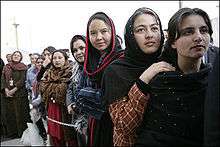 Women of Afghanistan in 2006 | |
| Gender Inequality Index | |
|---|---|
| Value | 0.712 (2012) |
| Rank | 147th |
| Maternal mortality (per 100,000) | 460 (2010) |
| Women in parliament | 27.6% (2012) |
| Females over 25 with secondary education | 5.8% (2010) |
| Women in labour force | 16% (2014)[1] |
| Global Gender Gap Index | |
| Value | NR (2012) |
| Rank | NR out of 144 |
Women's rights in Afghanistan have gradually improved in the last decade under the Karzai administration. Through different rulers such as the mujahideen and the Taliban in the later part of the 20th century, women had struggled to gain freedoms and reform a society that is primarily male dominant. Violence against women in Afghanistan remains high, and international observers noted improving as the country slowly progresses,[2] though rights groups have expressed renewed concerns in 2014.[3][4]
Overview


| Women in society |
|---|
 |
|
Sports |
|
By country
|
|
Afghans lived in Afghanistan for thousands of years. Of all of the ethnic groups, the Pashtuns are the largest followed by Tajiks, Hazaras, Uzbeks and others. From the 19th century and through the twentieth century the rulers of Afghanistan consistently attempted to lessen women's restrictions in the country. For the most part, these attempts were unsuccessful; however, there were a few leaders who were able to make some significant changes for the time period. Among them was King Amanullah, who ruled from 1919 to 1929 and made some of the more noteworthy changes in an attempt to unify as well as modernize the country.[5]
King Amanullah, along with other rulers following him, promoted freedom for women in the public sphere in order to lessen the control that patriarchal families had over women. King Amanullah stressed the importance for young girls and women to receive an education. Along with encouraging families to send their daughters to school, he promoted the unveiling of women and persuaded them to adopt a more western style of dress.[6] In 1921, he created a law that abolished forced marriage, child marriage, bride price, and put restrictions on polygamy, a common practice among households in Afghanistan.[6] However, over time these restrictions became nearly impossible to enforce.
Modern social reform for Afghan women began when Queen Soraya, wife of King Amanullah, made rapid reforms to improve women's lives and their position in the family. She was the only woman to appear on the list of rulers in Afghanistan and was credited with having been one of the first and most powerful Afghan and Muslim female activists. Queen Soraya, along with her husband's, advocacy of social reforms for women led to a protest and contributed to the ultimate demise of her and her husband's reign.[7]
Throughout the 20th century, Afghanistan continued to be a country dominated by tribes and men continued to have ultimate control over women. In 1973 the state was declared a republic and throughout the 1970s and 1980s a communist group called the People's Democratic Party of Afghanistan (PDPA) took over and attempted to once again reform the marriage laws, women's health laws, and encouraged women's education. During this time it made significant advances towards modernization.[8] Minorities of women were able to hold jobs as scientists, teachers, doctors, and civil servants and had a considerable amount of freedom with significant educational opportunities.[9] The majority of women, however, lived in poverty and were excluded from these opportunities. In 1977, the Revolutionary Association of the Women of Afghanistan (RAWA) was founded by Meena Keshwar Kamal in Kabul but her office was moved to Quetta in neighboring Pakistan where she was assassinated in 1987.[10] RAWA still operates in the region of Pakistan and Afghanistan.[11]
Mujahideen and Taliban era
In 1992, the peace and power-sharing agreement Peshawar Accord established the post-communist era Islamic State of Afghanistan. It was signed on 24 April 1992 by a number of the major Afghan anti-Soviet resistance parties except for the Hezb-e Islami of Gulbuddin Hekmatyar. The accord established an interim government for a transitional period to be followed by general elections.[12] War in Afghanistan continued into a new phase when Gulbuddin Hekmatyar started a bombardment campaign against the Islamic State and the capital city Kabul. It is reported that in 1970 Hekmatyar had thrown acid into the faces of women and shot them at Kabul University.[13]
The restrictions imposed when the Islamic State was established were "the ban of alcohol and the enforcement of a sometimes-purely-symbolic veil for women".[14] Women, however, remained in the workplace and the liberal provisions of the 1964 constitution were largely upheld. Women began to be more restricted after Hekmatyar was integrated into the Islamic State as Afghan Prime Minister in 1996. He demanded for women who appeared on TV to be fired. During the violent four-year civil war a number of women had been kidnapped and some of them raped. By the time one of the factions became victorious many people welcomed this new leading force known as the Taliban.[5]

Like their spiritual leader, Mullah Omar, the Taliban administrators were poor villagers almost entirely educated in Wahhabi schools in neighboring Pakistan.[5] Immediately after coming into power, the Taliban declared that women were forbidden to go to work and they were not to leave their homes unless accompanied by a male family member. When they did go out it was required that they had to wear an all-covering burqa. Under these restrictions, women were denied formal education.[6] Some women were unable to leave their households at all because they could not afford a burqa or they no longer had any male relatives. Women were usually forced to stay at home and paint their windows so that no one could see in or out.[9] During the Taliban's five-year rule, women in Afghanistan were essentially put under house arrest. Some women who once held respectable positions were forced to wander the streets in their burqas selling everything they owned or begging in order to survive. The United Nations refused to recognize the Taliban government, with the United States imposing heavy sanctions on them, similar as those placed on North Korea. This led to extreme hardship on all the citizens of Afghanistan.
Because most teachers had been women before the Taliban regime, the new restrictions on women's employment created a huge lack of teachers, which put an immense strain on the education of both boys and girls. Although women were banned from most jobs, including teaching, some women in the medical field were allowed to continue working.[9] This is because the Taliban required that women could be treated only by female physicians.[6] Moreover, for several reasons, it was difficult for women to seek medical attention. It was extremely frowned upon for women to need to go to a hospital, and those who did try to go to a hospital were usually beaten. Even when a woman was able to make it to a hospital she had no guarantee that she would be seen by a doctor.
Several Taliban and al-Qaeda commanders ran a network of human trafficking, abducting women and selling them into forced prostitution and slavery in Afghanistan and Pakistan.[15] Time Magazine writes: "The Taliban often argued that the brutal restrictions they placed on women were actually a way of revering and protecting the opposite sex. The behavior of the Taliban during the six years they expanded their rule in Afghanistan made a mockery of that claim."[15]
21st century
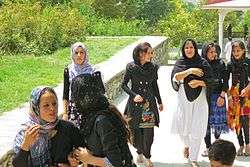
After the removal of the Taliban regime from Afghanistan a new government was formed. The Karzai administration has relaxed policies around women's rights, and in Kabul women can be seen driving cars and engaging in other activities that they would have previously been banned from participating in.[16]
In March 2012, President Hamid Karzai endorsed a "code of conduct" which was issued by the Ulema Council. Some of the rules state that "women should not travel without a male guardian and should not mingle with strange men in places such as schools, markets and offices." Karzai said that the rules were in line with Islamic law and that the code of conduct was written in consultation with Afghan women's group."[17]
Rights organizations and women activists say that by endorsing this code of conduct Karzai is endangering "hard-won progress in women's right since the Taliban fell from power in 2001.[18] The BBC reported that a number of women have reacted to the endorsement with humour. One Afghan woman working in London posted on Facebook "Ladies, you should not surface on Facebook without a male partner."
The overall situation for Afghan women has improved in the last decade, particularly in the major urban areas, but those living in rural parts of the country still face many problems. In 2013, a female Indian author Sushmita Banerjee was killed in Paktika province by militants for allegedly defying Taliban diktats. She was married to an Afghan businessman and had recently relocated to Afghanistan. Earlier she had escaped two instances of execution by the Taliban in 1995 and later fled to India. Her book based on her escape from Taliban was also filmed in a Bollywood film.[19]
Human rights organisations, including Human Rights Watch[3][20] and the United States Commission on International Religious Freedom[4] have expressed concern at women's rights in the country.
In 2013 the United Nations published statistics showing a 20% increase in violence against women, often due to domestic violence being justified by conservative religion and culture. In February 2014 Afghanistan passed a law that includes a provision that limits the ability of government to compel some family members to be witnesses to domestic violence. Human Rights Watch describes the implementation of the 2009 Law on the Elimination of Violence Against Women as "poor," noting that some cases are ignored. In 2013 four female police officers were killed. The same year, some parliamentarians proposed removing the minimum age of marriage. A 2011 government report found that 25 percent of the women and girls diagnosed with fistula were younger than 16 when they married.[21][22]
In 2015, Farkhunda was beaten to death by a mob on a false accusation of burning a Qur'an.
Politics and workforce

The most popular traditional work for women in Afghanistan is tailoring, and a large percentage of the population are professional tailors working from home.[23] Since 2002 women have gradually begun to work their way back towards being contributors to the economy. Some women became entrepreneurs by starting own businesses. For example, Meena Rahmani became the first woman in Afghanistan to open a bowling center in Kabul.[24] Many others are employed by companies and small businesses.
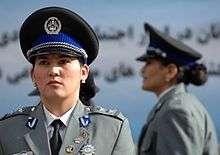
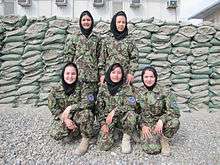

In the last decade a large number of women became members of the National Assembly of Afghanistan (Afghan Parliament), such as Shukria Barakzai, Fauzia Gailani, Nilofar Ibrahimi,[25] Fauzia Koofi, Malalai Joya, and many others. Several women also took positions as ministers, including Suhaila Seddiqi, Sima Samar, Husn Banu Ghazanfar, and Soraya Dalil. Habiba Sarabi, who belongs to the minority Hazara group, became the first female governor in Afghanistan. She also served as Minister of Women's Affairs. Azra Jafari is a female mayor in Nili, the capital of Daykundi Province.
The Afghan National Security Forces (ANSF), which includes the Afghan National Police, have a number female officers. One of the Afghan National Army Brigadier generals is Khatol Mohammadzai. In 2012, Lt. Nilofar Rahmani became the first female pilot in the Afghan Air Force pilot training program to fly solo.[26] The number of female military and police officers are growing as more are being trained to perform their duty on an international level. Many believe that this will open doors for other institutions to hire women in the future. Other notable Afghan women include Roya Mahboob, Aziza Siddiqui, Mary Akrami, Suraya Pakzad, Wazhma Frogh, Shukria Asil, Shafiqa Quraishi, Maria Bashir, Maryam Durani, Malalai Bahaduri, and Nasrin Oryakhil. In 2015 Negin Khpolwak, age 17, became Afghanistan's first female conductor.[27]
Because Afghanistan has a struggling economy overwhelmed with massive unemployment and poverty, women often cannot find work where they receive sufficient pay.[6] One area of the economy where women do play a significant role is in agriculture. Of the 80 percent of Afghans employed in the agriculture field or similar occupations, 30 percent of them are women.[6] In some areas in Afghanistan, women may spend as much time working on the land as men do, but still often earn three times less than men in wages.[6] According to World Bank, in 2014, women made up 16.1% of the labor force in Afghanistan.[28]
In terms of percentage women rank high in the fields of medicine and media, and are slowly working their way into the field of justice. Because women are still highly encouraged to consult a female physician when they go to the hospital, nearly fifty percent of all Afghans in the medical profession are women.[6] The number of women having professions in the media is also rising. Currently there are more than ten television stations that have all female anchors as well as female producers.[6] As women are given more opportunities in education and the workforce, more of them are turning towards careers in medicine, media, and justice.
However, even the women that are given the opportunity to have careers have to struggle to balance their home life with their work life, as household tasks are seen as primarily female duties. Since the economy is so weak, very few women can afford to hire domestic helpers, so they are forced to take care of all the household work primarily on their own.[6] Those who choose to work must labour twice as hard because they are essentially holding two jobs.
Education
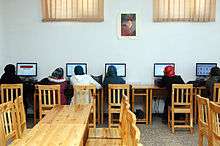
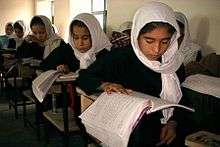
Education in Afghanistan is very low, especially for women, but this is now increasing due to the high number of girls attending schools throughout the country.[29] The literacy rate is lower for females (24.2%) than for males (52%) -2015 estimate, population 15 and older.[30] As of 2011, there are around 8 million students in Afghanistan, 37% of them are females.[31][32] About 82,000 students are enrolled in different universities around the country.[32]
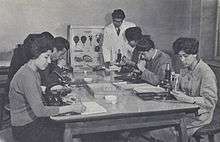
In the early twentieth century, education for women was extremely rare due to the lack of schools for girls. Occasionally girls were able to receive an education on the primary level but they never moved past the secondary level.[6] During Zahir Shah's reign (1933-1973) education for women became a priority and young girls began being sent to schools. At these schools, girls were taught discipline, new technologies, ideas, and socialization in society.[6]
Kabul University was opened to girls in 1947 and by 1973 there was an estimated 150,000 girls in schools across Afghanistan. Unfortunately, marriage at a young age added to the high drop out rate but more and more girls were entering professions that were once viewed as only being for men.[6] Women were being given new opportunities to earn better lives for both themselves and their families. However, in the after the civil war and the takeover by the Taliban, women were stripped of these opportunities and sent back to lives where they were to stay at home and be controlled by their husbands and fathers.
During the Taliban regime, many women who had previously been teachers began secretly giving an education to young girls (as well as some boys) in their neighborhoods, teaching from ten to sixty children at a time.[9] The homes of these women became community homes for students, and were entirely financed and managed by women. News about these secret schools spread through word of mouth from woman to woman. Each day young girls would hide all their school supplies, such as books, notebooks and pencils, underneath their burqas to go to school. At these schools, young females were taught basic literary skills, numeracy skills, and various other subjects such as biology, chemistry, English, Quranic Studies, cooking, sewing, and knitting. Many women involved in teaching were caught by the Taliban and persecuted, jailed, and tortured.[9]
The Taliban are still opposed to education for Afghan boys and girls. They are burning down schools, killing students and teachers by all kinds of means, including chemical warfare. For example, in June 2012, fifteen suspects were detained by Afghanistan's National Directorate of Security (NDS) "in connection with the serial anti-school attacks in northern Afghanistan." The NDS believes that Pakistan's Inter-Services Intelligence was behind the idea.[33] During the same period, Pakistan has been refusing to deliver Afghan bound school text books.[34]
In 2015 at Kabul University the first master's degree course in gender and women’s studies in Afghanistan began.[35]
Rural women
In Afghanistan, most of the population is rural; only 26.7% of the population is urban.[36] Most of these people depend on agriculture. Women in rural areas have been badly affected by war, and have been denied, in law and in practice, access to fundamental rights and services. Nevertheless, because rural women had less rights than urban women, they had less to lose under the Taliban regime.[37] Women in rural areas are involved in agriculture, livestock tending, food preparation and caring for children and elderly. In parts of the country (northern and central regions) women also do textile work (carpets and kelims), with such work taking place within the home.[38]
Sport
In the last decade Afghan women have participated in various types of sports including futsal, football, and basketball. In 2015 Afghanistan held its first marathon; among those who ran the entire marathon was one woman, Zainab, age 25, who thus became the first Afghan woman to run in a marathon within her own country.[39]
Marriage and parenting
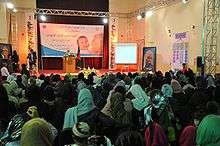
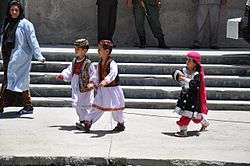
Afghanistan is a patriarchal society where it is commonly believed that men are entitled to make decisions for women, include those pertaining to engagement and marriage.[40] A man can divorce without needing his wife's agreement, whereas the opposite is not true.[41]
Afghanistan has a high total fertility rate, at 5.33 children born/woman as of 2015.[42] Contraception use is low: 21.2% of women, as of 2010/11.[43]
Arranged marriages are common for women in Afghanistan and they are done mostly for political and economic reasons. A girl's father has the ultimate authority over who he believes his daughter should marry. It is not uncommon for girls to be engaged even before they are born. Girls are often married off at a very young age to wealthy men who are much older than themselves. Reports have even indicated that in the most poverty-stricken areas of rural Afghanistan, families have been reduced to selling their daughters to much older men in exchange for food.
After a marriage is arranged, the two families sign an engagement contract that both parties are socially and culturally obligated to honor. After this contract is signed, the bride is forbidden to marry another man.[44] If the bride dies before the marriage, her family is required to give her sister as a bride or find another desirable replacement.[44]
It is common among low-income families in most areas of the country for the groom to pay a bride price to the bride's family.[40] The price is negotiated among the heads of the family; the bride herself is not included in the negotiation process. The bride price is viewed as compensation for the money that the bride's family has had to spend on her care and upbringing.[40] There have been many instances where a family is so stricken by poverty that a father will betroth his daughters to multiple men and collect the bride price from each of them.[40] The resulting disputes, although addressed by the courts, often lead to violent reprisals. Girls are sometimes also bartered in a traditional method of dispute resolution called baad that proponents say helps avoid violence between families, although the girls themselves are often subject to considerable violence both before and after marrying into a family through baad.[45]
In many cases, once a girl is married she becomes the property of her new family and continues to have little to no control over her situation. In family matters, the girl's mother-in-law and her husband have the most control. In most cases, it is the mother-in-law, who decides whether or not her pregnant daughter-in-law should go to the hospital or not.[6]
Under the Afghan law, "if a woman seeks a divorce then she has to have the approval of her husband and needs witnesses who can testify in court that the divorce is justified."[41] The first occurrence of a woman divorcing a man in Afghanistan was the divorce initiated by Rora Asim Khan, who divorced her husband in 1927.[46] This was described as unique at the time it occurred, but this was an exception, as Rora Asim Khan was a foreign citizen, who obtained her divorce by assistance from the German embassy.[46]
International aid to Afghan women
International aid comes in many different forms and many different countries and organizations. International aid has been a staple for the Afghan economy in the past and in the present. Motivations for aid, the impact of aid, and how long the aid is provided varies.
Who provides aid?
Many European and Western countries provide aid to the women of Afghanistan. The United Kingdom, the United States, Canada, Germany, and France are all examples of countries that provide aid to the women of Afghanistan.[47] In addition, based these countries, there are organizations who help Afghani women. Sometimes these organizations range from being humanitarian to a more narrow range based (like providing one specific type of help). Larger known organizations like the World Health Organization and the United Nations also provides aid through programs such as UNICEF.[48] The United States and France have been involved in both humanitarian and armed interventions in Afghanistan since 2001.[49] For example, both the United States and France have soldiers in order to remove the Taliban. These countries also have humanitarian based organized placed there as well. A French organization called Mecidine du Monde helps purely for humanitarian reasons, instead of political. The United States also focuses on humanitarian based outreach through organizations like Woman to Woman and USAID.
Forms of aid
Health care is an aspect international organizations have focused on. The United Nations through UNICEF has been providing health care for women and children.[48] They focus on aspect like maternal mortality rate, because in Afghanistan, maternal mortality for women is at a high rate.[48] It was estimated that in 1996, the maternal mortality rate was 820 deaths per 1000 live births in Afghanistan.[48] This number has grown to 1,400 deaths to 100 live births, making Afghanistan the country with the highest maternal mortality rate.[50] Educational resources are also provided. For many organizations educating the women of Afghanistan is a key priority. Approximately 80% of the women in Afghanistan are illiterate, and this percentage only increases in the rural areas of Afghanistan.[51] Other organizations are focused on the development of Afghanistan. For example, Habitat for Humanity International helps to build homes for the Afghan citizens who live in poverty.[52] It is difficult for some of the citizens of Afghanistan to have developed homes and buildings since 36% of the population lives in poverty.[50] Since Afghanistan is mostly an agricultural society, it becomes more difficult to build homes in rural area and even more difficult to obtain electricity, sanitation, and water. Currently on 6% of Afghanistan has the ability to have electricity, further slowing development.[53] Only 30% of the country has the access to proper sanitation.[50] In addition, only 22% of the country has access to adequate water sources.[50] How much countries and organizations invest: Afghanistan has received approximately $67 billion international aid.[50] Along with the American-based organizations, the United States military has also intervened stating one of its reasons as being to help create equality for women. The United States has spent about $52 billion since 2001 towards the work being done in Afghanistan, most of which goes directly to funding Afghan forces.[49] In addition to the military appearance, USAID has provided the support to complete humanitarian works. They would do this in providing schools, medical care, and democracy to better conditions for women.[49] Approximately 31% of the budget towards Afghanistan goes to programs that help the development of the country and its people.[49]
Time frame of involvement
Aid to Afghanistan, in particular, from the United States has existed for many years. During the time of the Cold War, international aid accounted for 40% of the national budget of Afghanistan.[54] The United States provided aid programs until 1979, when the Soviet Union occupied Afghanistan.[54] It was not until the 1990s that the United States, other Western countries, and the United Nations became to reorganize aid programs in Afghanistan.[54]
Conflicts when providing aid
Religious, political, and cultural tensions exist between those who provide aid and those who accept aid. Since Afghanistan is a predominantly Muslim nation, different interpretations of equality can sometimes clash with Western ideals.[53] Below are topics and arguments that arise about providing aid: 1) Does the aid help or hurt? 2) How to approach the religious differences between those who give aid and those who receive aid.
Side of those who believe aid helps
For some people, the belief is that international helps is supported by progress the country continues to make towards equality. Human rights and equality drive the motivation to keep helping the women of Afghanistan. Some people in Western countries see the women in Afghanistan as not having equality; some of this belief comes from the issue of the veil. Westerns see the veil as sign of oppression to women, calling them to hide their faces and that they are lower than men on the social scale. However, to the women of Afghanistan, opinions of the veil may vary for social and religious reasons. Some women recall that the veil to them is not a symbol of oppression, but a chance for equality.[55] For example, some women may see the veil as creating an equal playing field because then they are not judged solely on their appearance, and others see it as a form of modesty for religious reasons.[55] However, from this there is still controversy over is the veil actually creates equality. Foreign aid organizations face the challenge of trying to or not to impose Western ideals in regards to the veil, but with that decision also shows the different approaches of providing aid. Other arguments for helping the women of Afghanistan are to promote equality. Some Westerns see Afghan women as relying on their husbands to provide for them. Women do not receive an education, are able to work outside the home, and social justice appears limits.[56] For example, rape and other sexual assault victims are not always able to receive the medical help and judicial implications necessary for them.[57] In addition women lack the skills in order to become independent. The literacy rate amongst Afghani women is extremely low and hinders women from being able to progress as equals. Issues of illiteracy, health care, and social justice are lacking, and the only to resolve this through the eyes of some people is for international aid to provide solutions.[58]
Arguments against aid to Afghan women
However, there are also arguments against providing international aid to the women of Afghanistan. The argument is based on opposition to imperialism, that the women of a developing country do not need to be saved by Western developed countries. This focuses on how it is not necessarily Western countries' responsibility to impose their ideals and wants on developing nations. In addition, this argument focuses on how we should not use the women of a country as an excuse to intervene Western ideals. Western countries have had imperialistic actions towards other countries for centuries, and those who see international aid as detrimental to the Afghani women argue that by providing aid and intervening, Western countries are still imposing their view, only this time it is not with weapons and war, it is through gradual change with the women and children.[58] It is seen as not pure intentions to help others, but to spread Western ideals amongst countries that are in need. The main idea that maybe Afghani women do not need to be saved, but instead left to develop freedom and equality on their own in their own way.[54]
See also
- Women for Afghan Women
- Revolutionary Association of the Women of Afghanistan
- Afghan Women's Network
- Afghan Women's Council
- Afghan Women's Business Federation
- Access for Afghan Women Act
- Afghanistan women's national football team
- Afghanistan national women's cricket team
- Prostitution in Afghanistan
- The Afghan Women
- Women in Islam
- Women in Arab societies
- Women in agriculture in Afghanistan
- DIY Creations - Empowering women through business startups in Afghanistan
- Humira Saqib
References
- ↑ http://data.worldbank.org/indicator/SL.TLF.ACTI.FE.ZS/countries
- ↑ "Four Afghan Men Held in Acid Attack on Family". ALISSA J. RUBIN and ROD NORDLAND. The New York Times. 10 December 2011.
- 1 2 "World Report 2014: Afghanistan". Human Rights Watch.
- 1 2 "USCIRF Annual Report 2014 – Tier 2: Afghanistan". United States Commission on International Religious Freedom. 30 April 2014.
- 1 2 3 Keddie, Nikki R. (2007). Women in the Middle East. Princeton University Press. ISBN 978-0-691-12863-4.
- 1 2 3 4 5 6 7 8 9 10 11 12 13 14 Skaine, Rosemarie (23 September 2008). Women of Afghanistan In The Post-Taliban Era: How Lives Have Changed and Where They Stand Today. McFarland. ISBN 978-0-7864-3792-4.
- ↑ "A History of Women in Afghanistan: Lessons Learnt for the Future" (PDF). Dr. Huma Ahmed-Ghosh. Aletta, Institute for Women's History. May 2003. Retrieved 2 December 2010.
- ↑ Armstrong, Sally (6 January 2003). Veiled Threat: The Hidden Power of the Women of Afghanistan. Seal Press. ISBN 978-1-56858-252-8.
- 1 2 3 4 5 Rostami-Povey, Elaheh (16 October 2007). Afghan Women: Identity and Invasion. Zed Books. ISBN 978-1-84277-856-2.
- ↑ Toynbee, Polly (28 September 2001). "Behind the burka". The Guardian.
- ↑ "About RAWA". Revolutionary Association of the Women of Afghanistan.
- ↑ Amin Saikal. Modern Afghanistan: A History of Struggle and Survival (2006 1st ed.). I.B. Tauris & Co Ltd., London New York. pp. 214–215. ISBN 1-85043-437-9.
- ↑ Nikki R. Keddie. Women in the Middle East: Past and Present. p. 118.
- ↑ William Maley. Fundamentalism Reborn?: Afghanistan and the Taliban. p. 207.
- 1 2 "Lifting The Veil On Taliban Sex Slavery". Time Magazine. 10 February 2002.
- ↑ Elizabeth Rubin. 'Veiled Rebellion', National Geographic Magazine. December 2010.
- ↑ "Hamid Karzai backs clerics' move to limit Afghan women's rights". The Guardian. London. 6 March 2012.
- ↑ "Hamid Karzai under fire on Afghan women's rights". The Daily Telegraph. London. 9 March 2012.
- ↑ "Indian Author Sushmita Banerjee killed by Taliban in Afghanistan". Retrieved 5 September 2013.
- ↑ "World Report 2015: Afghanistan". Human Rights Watch.
- ↑ "Afghanistan: Child Marriage, Domestic Violence Harm Progress". Human Rights Watch. 4 September 2013.
- ↑ "Escaping Child Marriage in Afghanistan". UNFPA. 4 October 2012.
- ↑ Afghan women struggle to make ends meet as tailors
- ↑ In Kabul, a bowling center offers respite from war
- ↑ US Embassy Kabul Afghanistan (20 March 2011). "Untitled | Flickr - Photo Sharing!". Secure.flickr.com. Retrieved 10 November 2015.
- ↑ "U.S. training helps Afghan female pilot go solo". Air Force Times. 22 October 2012. Retrieved 5 January 2013.
She is one of five pilot trainees in UPT Class 12-03 — the class has months of training ahead prior to receiving their wings and will graduate next summer. She has received accolades from the Afghan public and is viewed as a positive role model for Afghan females.
- ↑ "Afghanistan's first female conductor". BBC.com. 10 November 2015. Retrieved 10 November 2015.
- ↑ http://data.worldbank.org/indicator/SL.TLF.TOTL.FE.ZS
- ↑ Rising literacy in Afghanistan ensures transition. By Rob McIlvaine, ARNEWS. 13 June 2011.
- ↑ https://www.cia.gov/library/publications/the-world-factbook/geos/af.html
- ↑ "ISAF Spokesman Discusses Progress in Afghanistan". International Security Assistance Force/NATO. 25 July 2011. Retrieved 6 December 2011.
- 1 2 "Education". United States Agency for International Development (USAID). Retrieved 11 August 2011.
- ↑ Zarghona Salehi, ed. (6 June 2012). "15 held for poisoning schoolgirls: Mashal". Pajhwok Afghan News.
- ↑ Zarghona Salehi, ed. (12 May 2012). "Afghan students to Pakistan: Release our books". Pajhwok Afghan News.
- ↑ FaithWorld (26 October 2015). "Kabul University unlikely host for first Afghan women's studies programme". Blogs.reuters.com. Retrieved 2 November 2015.
- ↑ https://www.cia.gov/library/publications/the-world-factbook/geos/af.html
- ↑ http://www.fao.org/english/newsroom/highlights/2002/020105-e.htm
- ↑ http://www.cmi.no/publications/file/5299-working-with-gender-in-rural-afghanistan.pdf
- ↑ "Feminist Daily News 10/29/2015: Afghan Woman Runs in Country's First Marathon". Feminist.org. 29 October 2015. Retrieved 2 November 2015.
- 1 2 3 4 Hafizullah, Emadi (30 August 2002). Repression, Resistance, and Women in Afghanistan. Praeger. ISBN 978-0-275-97671-2.
- 1 2 "Divorce, suicide; 'Hell' in Herat". Golnar Motevalli. Revolutionary Association of the Women of Afghanistan. 23 July 2009.
- ↑ https://www.cia.gov/library/publications/the-world-factbook/geos/af.html
- ↑ https://www.cia.gov/library/publications/the-world-factbook/geos/af.html
- 1 2 Rodriguez, Deborah (10 April 2007). Kabul Beauty School: An American Woman Goes Behind the Veil. Random House. ISBN 978-1-4000-6559-2.
- ↑ Institute for War and Peace Reporting, Afghan Girls Suffer for Sins of Male Relatives, 26 March 2009, ARR No. 317, available at: http://www.unhcr.org/refworld/docid/49dc4b201c.html [accessed 5 December 2010]
- 1 2 Rora Asim Khan (Aurora Nilsson): Anders Forsberg och Peter Hjukström: Flykten från harem, Nykopia, Stockholm 1998. ISBN 91-86936-01-8.
- ↑ Alesina, Alberto; David Dollar (March 2000). "Who Gives Foreign Aid to Whom and Why?". Journal of Economic Growth. 5 (1): 33–63. doi:10.1023/A:1009874203400.
- 1 2 3 4 Turner. "Literature Review: Afghanistan Women's Health Crisis, Health Service Delivery, and Ethical Issues for International Aid". Health Care for Women International: 748–759. horizontal tab character in
|title=at position 70 (help) - 1 2 3 4 Tarnoff, Curt (2010). Afghanistan: U.S. Foreign Assistance. Congressional Research Service: 1–23. Missing or empty
|title=(help) - 1 2 3 4 5 CIA World Factbook
- ↑ "Asia Foundation.org".
- ↑ "Habitat for Humanity.org".
- 1 2 Sharp, Trueman; Fredrick Burkle Andrew Vaughn Rashid Chotani Richard Bennan (2002). "Challenges and Opportunities for Humanitarian Relief in Afghanistan". Infectious Diseases. 34: 215–225. Cite uses deprecated parameter
|coauthors=(help) - 1 2 3 4 Goodhand, Jonathan (2002). "Aiding Violence or Building Peace? The Role of International Aid in Afghanistan". Third World Quarterly: 837–850. doi:10.1080/0143659022000028620.
- 1 2 Abu-Lughod, Lila. "Saving the Muslim Women".
- ↑ Baker, Aryn (2010). "Afghan Women and the return of the Taliban". Time: 20–28.
- ↑ Jones, A. "Letters form Afghanistan". Nation: 17–19.
- 1 2 Alesina, Alberto; David Dollar (March 2000). "Who gives Foreign Aid to Whom and Why?". Journal of Economic Growth. 5 (1): 33–63. doi:10.1023/A:1009874203400.
External links
| Wikimedia Commons has media related to Women of Afghanistan. |
- Afghan Women - National Geographic
- A Place At The Table: Safeguarding Women's Rights in Afghanistan
- The World Factbook
- Women, Afghan Law, and Sharia